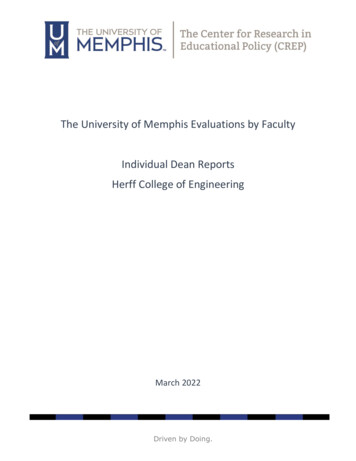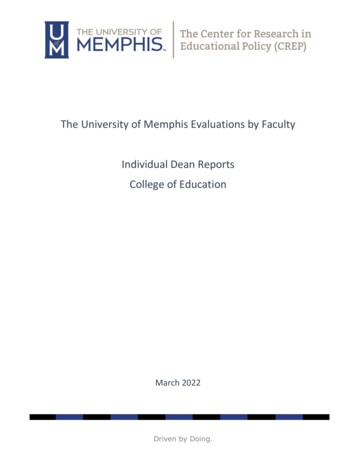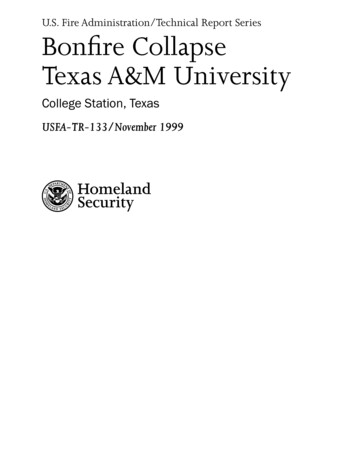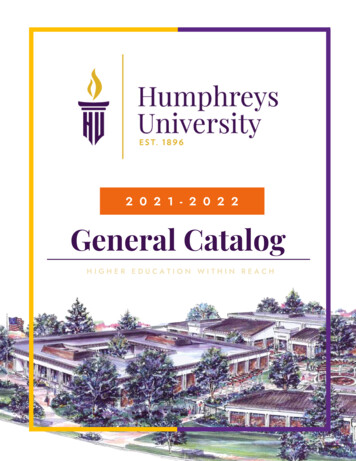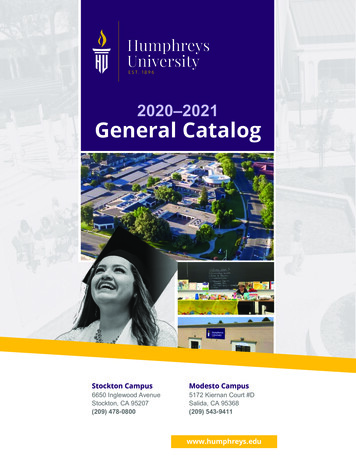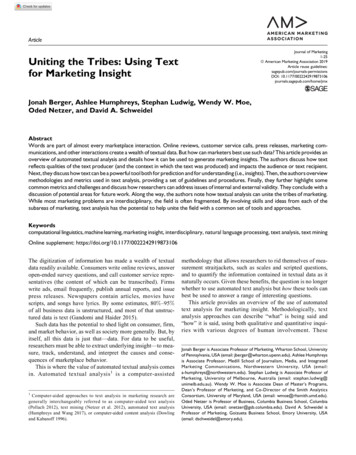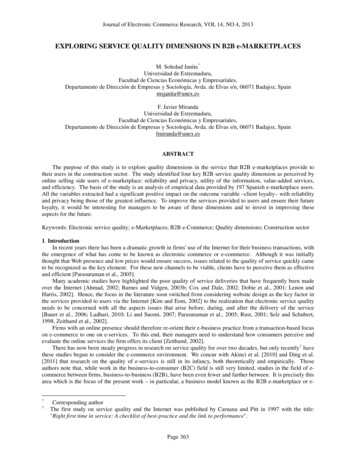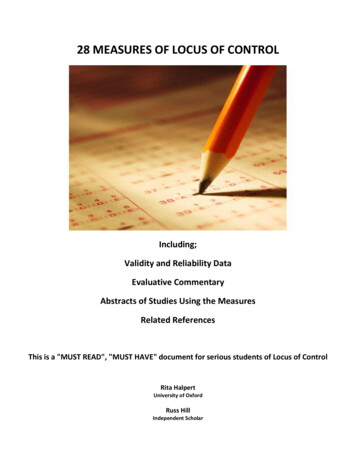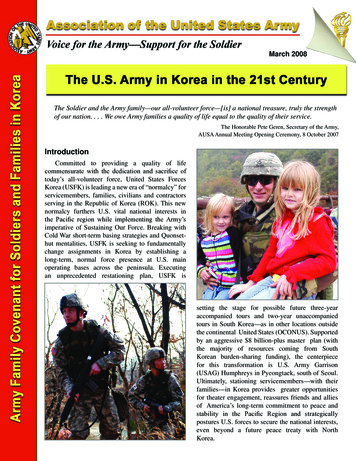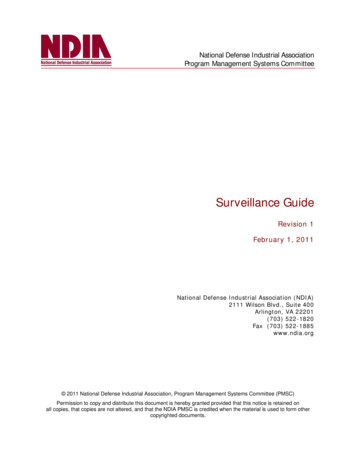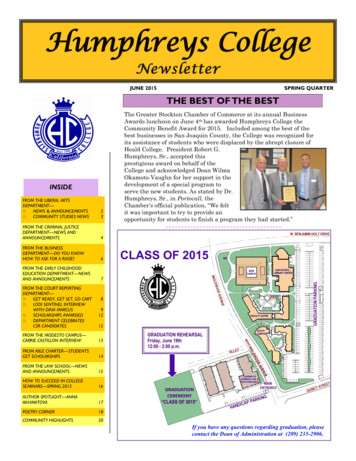
Transcription
Humphreys CollegeNewsletterJUNE 2015SPRING QUARTERTHE BEST OF THE BESTINSIDEFROM THE LIBERAL ARTSDEPARTMENT— NEWS & ANNOUNCEMENTS COMMUNITY STUDIES NEWS23FROM THE CRIMINAL JUSTICEDEPARTMENT—NEWS ANDANNOUNCEMENTS4FROM THE BUSINESSDEPARTMENT—DO YOU KNOWHOW TO ASK FOR A RAISE?6FROM THE EARLY CHILDHOODEDUCATION DEPARTMENT—NEWSAND ANNOUNCEMENTS7FROM THE COURT REPORTINGDEPARTMENT— GET READY, GET SET, GO CART LODI SENTINEL INTERVIEWWITH DINA MARCUS SCHOLARSHIPS AWARDED DEPARTMENT CELEBRATESCSR CANDIDATESThe Greater Stockton Chamber of Commerce at its annual BusinessAwards luncheon on June 4th has awarded Humphreys College theCommunity Benefit Award for 2015. Included among the best of thebest businesses in San Joaquin County, the College was recognized forits assistance of students who were displaced by the abrupt closure ofHeald College. President Robert G.Humphreys, Sr., accepted thisprestigious award on behalf of theCollege and acknowledged Dean WilmaOkamoto-Vaughn for her support in thedevelopment of a special program toserve the new students. As stated by Dr.Humphreys, Sr., in Portocall, theChamber’s official publication, “We feltit was important to try to provide anopportunity for students to finish a program they had started.”891212FROM THE MODESTO CAMPUS—CARRIE CASTILLON INTERVIEW13FROM ABLE CHARTER—STUDENTSGET SCHOLARSHIPS14FROM THE LAW SCHOOL—NEWSAND ANNOUNCEMENTS15HOW TO SUCCEED IN COLLEGESEMINARS—SPRING 201516AUTHOR SPOTLIGHT—ANNAAKHMATOVA17POETRY CORNER18COMMUNITY HIGHLIGHTS20If you have any questions regarding graduation, pleasecontact the Dean of Administration at (209) 235-2906.
JUNE 2015HUMPHREYS COLLEGEPAGE 2FROM THE LIBERAL ARTS DEPARTMENT NEWS AND ANNOUNCEMENTSBy Cynthia S. Becerra, Dean of Instruction, ChairOn Wednesday, May 20th the Department hosted its annual Alumni Panel Presentation on Career and EducationalOpportunities in the Fields of Liberal and Community Studies. Both Dr. Richard Chabot, coordinator of thecommunity studies program, and I invited four speakers to share with students, faculty, and staff their experiencessince earning their degrees: Karen Turk-Gennoe, a 2014graduate in Liberal Studies, isnow in our master’s program ontrack to earn both her graduatedegree and her preliminaryMultiple Subject Credential; Tanya Bennett, a 2011 graduatein Liberal Studies, is now theHead of Children’s Services forthe Child Abuse PreventionCouncil (CAPC), having earnedher master’s degree in ECE from Grand Canyon University in 2012; Marnelyn Pablo, a 2011 graduate in Community Studies, who recently formed her ownnonprofit M & J Helping Hands Inc., is employed with a financial management agency as well asa devoted mother to her two sons, Joseph and TJ; Ella Holman, a Community Studies graduate from the class of 2011, was featured in the SanJoaquin Women’s Magazine as the Woman of the Year for her volunteering; currently a HousingSpecialist for Aspiranet Foster Agency that provides transition for those who age out of the fostercare system, she continues to work as a realtor.With over twenty-five in attendance, the event brought together four dynamic women who had chosendiverse paths. In fact, during the question-answer forum, the speakers began to “network” with one another asthey encouraged students to do the same. Ms. Turk-Gennoe, a Humphreys College tutor, emphasized theimportance of listening to one of her friends who pressured her to apply to our college. Both now are Humphreysstudents. Ms. Holman magnified the signifance of working in our community to form connections and forself-fulfillment. Ms. Pablo detailed how her choice was influenced by her son’s disabilities and the need to secureservices for him. Ms. Bennett noted that coming back to Stockton, after living in North Carolina, was important toher and her family. She imparted that working in this community in such a worthwhile organization as CAPC hasencouraged her to move forward with her education and complete her doctorate.Following the presentations, all in attendance sampled the pizza and cookies. Four raffle prizes ofStarbucks gift cards were awarded.The Community Studies Program Review has been completed. With Dr.Chabot’s thorough self-study and a program review committee, headed by Dr. BeverlyClark and including faculty members Dr. Stanislav Perkner, Laura Poirier, and alumnaMaria Janet Rodriguez, the results were positive and will assist the program inimproving educational effectiveness. In addition, the external reviewer, Dr. Amy Liu,from CSU, Sacramento, acted as a consultant in the program review process.(Continued on page 3)
JUNE 2015HUMPHREYS COLLEGEPAGE 3(Continued from page 2)If you have not registered for Summer Quarter yet, plan to do so soon. The quarter starts July 6 th, so seeyour academic advisor as soon as possible. For liberal arts majors, make an appointment with one of the following:Professor Leslie Walton, (209)235-2956; Professor Crystal Hootman, (209)235-2943; or Professor Cynthia Becerra,(209)235-2922. For community studies majors, call Dr. Richard Chabot at (209)235-2930.COMMUNITY STUDIES NEWS RURAL PROBLEMS AND PROSPECTSCS296: An internet hybrid social science course for summer 2015*Field trips every other Saturday with online resources and discussionHave you driven east on Hammer or March Lanerecently? At the ends of these roads you will find cherryorchards, recently harvested with the fruit destined forJapan, San Francisco, and destruction. Keep driving intoCalaveras County and note the large number of recentlybuilt but very well hidden subdivisions, small estateswith huge houses, and the occasional meth lab. Go ruralanywhere in the U.S. and you’ll find yourself surroundedby commuting nightmares, Rancher wannabes, creepingsuburbias gone bust, a lack of jobs, and locals who can’tafford to live on the land they grew up in. This summerHumphreys College is offering a hybrid course on ruralrealities that relies on text, online resources, and short field trips to understand what makes up rural America andhow our area is being affected by globalization, population growth, and urban sprawl.Contact Professor Chabot for more information.*This is an internet hybrid course that meets only every other Saturday morning for field trips to local pointsof interest in our study of rural life and economy in San Joaquin County.MODERN EAST ASIA AND ITS HISTORYDo you know why. . . the Chinese were the first nationality tobe barred from immigrating to the U.S. . . Filipinos speaksuch good English. . . the Japanese economy rebounded soquickly after World War II. . . the U.S. has so many troops inSouth Korea. . . Vietnam turned Communist. . . the Presidentof Taiwan (ROC) can’t even visit the United States. . . ? Ifthese topics hold any interest for you, or if you simply want toknow more about that region of the world that is about toblow by the American economy so fast we’ll be breathing their exhaust fumes for thenext century, take the Modern Asian History course (HIST120) being offered online byDr. Chabot this summer quarter. For more information, check the summer courseschedule and contact your favorite academic advisor.
JUNE 2015HUMPHREYS COLLEGEPAGE 4FROM THE CRIMINAL JUSTICE DEPARTMENT NEWS AND ANNOUNCEMENTSBy Shana Brucia, ChairCriminal Justice ProgramThe Criminal Justice Program offers an Associate in Art and a Bachelor of Science Degreewith several concentrations. The two most popular concentrations are Law Enforcementand Corrections / Probation / Parole. The College hired two new adjunct instructors: Lt.Shad Canestrino, Lieutenant for Lodi Police Department, who will be teaching Crim 131 Gangs and Drugs, and Eric Gora, Sergeant for Pleasanton Police Department, who will beteaching Crim 230 - Sexual Offense and Offenders, in summer 2015.Probation Officer Core Course (Probation Academy)The Probation Academy class 2015 will be graduating on June 26. The graduates will have completed an intensive212-hour course designed on the STC model. The cadets were tested on various topics both in practical and writtenform. They participated in hands-on training for report writing and oral interview skills, as well as juvenile andadult justice systems processes, legal foundations for probation and terminology, restitution, fines, and otherpayment, case information and management as well as record keeping, court reports and presentations, codes,statutes and case law, indicators of psychological problems, gang affiliation indicators, interviewing andcounseling. This course is designed to provide practical training in police tactics and weapon usage. It includeddemanding classroom training exercises and a rigorous physical weaponless defense training.CONGRATULATIONS STC CADET GRADUATES!Criminal Justice Club – Beta Alpha SigmaOn March 31, Beta Alpha Sigma Club held a Criminal Justice Workshop onDrugs Abuse. It was hosted by Lt. Sierra Brucia from Lodi Police Department(Instructor at Humphreys College in the Criminal Justice Department). Thestudents learned about a variety of different drugs, including theirmanufacturing, transportation, sales, and the effects on the body. Studentsalso learned about new upcoming drugs and trends; they saw various typesof drugs during a “show and tell” workshop.Beta Alpha Sigma is a club designed to1.2.3.4.“Improve criminal justice through educational activities,Foster professionalism in law enforcement personnel and agencies,Promote professional, academic, and public awareness of criminal justice issues,Encourage the establishment and expansion of higher education and professional training incriminal justice,5. Provide a unified voice for professionals in, and students of criminal justice, and6. Promote high standards of ethical conduct, professional training, and higher education withinthe criminal justice field.”(Continued on page 5)
JUNE 2015HUMPHREYS COLLEGEPAGE 5(Continued from page 4)Beta Alpha Sigma’s Next WorkshopOn June 9th and June 16th, from 4 p.m. to 6 p.m. in Room 419 atHumphreys College, the club will be hosting a KIDNAPPED symposium,featuring kidnapped victim Katie Romanek, Retired Chief of Lodi PoliceLarry Hansen, and Retired Police Officer / Sketch Artist Robin Burcell.For the first time since her 1994 abduction from the Lodi familyresidence, Katie will be talking about her experiences and the importanceof resilience. Chief Hansen will be discussing the police procedure thatled to Katie’s rescue, and Officer Burcell will discuss her FBI-trainedforensic artistry and her role in creating the composite sketch of thesuspect.This symposium is open to all students; however, seating islimited, so please sign up with Shana Brucia by calling 546-6080 or emailat shana.brucia@humphreys.edu.Criminal Justice Department Chair NewsI am currently the Vice-President of the Lodi Crime Stoppers Board and theLodi Police Foundation Board. I have been a member of these two organizationsfor two years. On March 26, The Lodi Police Foundation Board received the2014 Chief’s Award from Lodi Police Department Chief of Police Mark Helms.Chief Helms presented this award to the foundation for our commitment to thecommunity through our ambitious fund raising in excess of 200,000, topurchase and provide an armored rescue vehicle for the Lodi PoliceDepartment. This vehicle will help ensure the Lodi community is safe andpublic safety guardians are prepared when tragedy strikes. I am honored to bea part of this group of people who show such a high degree of professionalismand integrity within the community.On May 11, I was recruited as a volunteer by Lt. ShadCanestrino from the Lodi Police Department, who was the IncidentCommander for the Stage 2 (LODI) - 2015 Amgen Tour of California.The Amgen Tour is a cyclist race which is eight days long. Cyclists bikefrom Sacramento to Nevada City, Nevada City to Lodi, Lodi to San Jose,San Jose to Pismo Beach, Pismo Beach to Avila Beach, Avila Beach toSanta Barbara, Santa Barbara to Santa Clarita, Santa Clarita toOntario, Ontario to Mt. Baldy, and Mount Baldy to Pasadena. Needlessto say, I was thrilled to be a part of this monumental day in Lodi’shistory. It was a tremendous event for the city, bringing thousands ofpeople to Hutchins Street Square to cheer on the 144 cyclists crossingthe finish line. This event put Lodi on the map as it was broadcastaround the world. Congratulations on a successful event, Lt. Canestrino(Instructor at Humphreys College in the Criminal Justice Department)!
JUNE 2015HUMPHREYS COLLEGEPAGE 6FROM THE BUSINESS DEPARTMENT.DO YOU KNOW HOW TO ASK FOR A RAISE?By Jason K.Wolins, ChairQuick show of hands: How many of you think you are being paid more than you’re worth?How many have employers who just walk up to employees each year and offer pay raises?A March 29, 2015, article in The Sacramento Bee, p. D9, entitled“How to ask for a raise” asserts that it is the responsibility ofemployees to approach their superiors about pay increases. Hereare some things it presented.Asking for a raise is stressful and raises some other questions:1. How should you best handle the topic?2. What should you do if your supervisor says, no?3. What is a reasonable salary or wage?So, how should you prepare for a meeting to ask for a raise? Here are some suggestions: Do your research. Research what others in similar positions are being paid. Try typing “salary calculator”or something similar in your search box and see what comes up.For example, one resource that came up when I tried it was http://salary.careerbuilder.com/. Calculate how long you have worked at your firm. If you have worked at an organization a long time,that may be in your favor. And, don’t forget to say how much you enjoy working there and what a good job youhave been doing.Remember, it may cost more money to replace you than if your employer just gives you a raise. Look at your company’s financial condition. Just the goings on around the office may be tip offs. Someexamples: Your employer has eliminated jobs, taken away incentives, stopped those office parties, etc.Use some common sense—if you see these red flags, it may be a good idea to wait until things improve to askfor a raise. Practice your sales pitch. Go over the reasons you feel you deserve a raise. Assemble your proof. Forexample, in a sales-based job, prepare a spreadsheet of your sales; present any customer testimonials you have. What would you do if your request for a raise is denied? One possibility: Look for another job. Butwhat if it’s just a bad time to ask for a raise? Maybe ask your supervisor when it may be the right time to askagain.One other possibility: Try negotiating for some other benefits, like maybe a gym membership or child-careexpenses. Choose a good time for an appointment with your supervisor. Wait until deadlines are over or yoursupervisor has returned from a vacation. You want your boss relaxed and in a good mood!So, if you feel you are going above and beyond the call of duty at work, present your case for a raise. And, goodluck, of course.(Continued on page 7)
JUNE 2015HUMPHREYS COLLEGEPAGE 7(Continued from page 6)Business Department Community Activities UpdateThis is the time of year where there are 1) two accounting/finance student nightbanquets, 2) an on-campus scholarship award ceremony and career night, and 3) aChamber of Commerce award luncheon. Here are some recent Business Departmentcommunity activities in these areas: On March 19, the Institute of Management Accountants (IMA) chapter in Modesto held its annual studentnight banquet for Accounting and Finance students. Ten Humphreys students attended. On April 22, the Stockton IMA chapter held a similar banquet. Nine Humphreys students attended. On June 1, two local Risk Management Association (RMA) chapter representatives and an accountant who is amember came to the Humphreys campus to award an annual RMA scholarship and give a presentation aboutthe RMA and careers with organizations that deal in risk management (such as banks, and accounting firms). On June 4, department chair Jason Wolins attended the annual Greater Stockton Chamber of CommerceAnnual Business Awards Luncheon as part of the Humphreys College contingent. Humphreys Collegereceived the Community Benefit Award for its outreach to former Heald College students.FROM THE EARLY CHILDHOOD EDUCATION DEPARTMENT.NEWS AND ANNOUNCEMENTSBy Pam Wood, ChairOur Early ChildhoodEducation Department enjoyedanother annual WEEK of theYOUNG CHILD celebration.The focus of this year’s eventwas based our ECE ProgramReview, which recommendedthat we pair up with acommunity organization. Our recent visit to ChildAbuse Prevention Council (CAPC) resulted in forminga partnership with theagency. Many of ourHumphreys College ECEstudents and alumni areemployed at Child Abuse Prevention Council whichmakes our partnership even more meaningful.During this year’s celebration, our studentswere involved in the Pinwheels for Preventionprogram and collected funds to be donated tothe Child Abuse Prevention Council. Thankyou to our Modesto campus staff and studentswho also took part in this program!Shauna Bazuniz-Jacob, in charge ofDevelopment/Community Outreach, attended ourECE 101, Child Development class, adding to theirstudy of community resources in our area. ShaunaBazuniz-Jacob was also the guest speaker along withHumphreys alumna Tanya Bennett, who is theDirector of Children’s Services at CAPC, for the springquarter Academic Council sponsored workshop thatwas held on Thursday, April 16. Staff and studentsenjoyed this event and were made aware of thenumerous programs sponsored by our local ChildAbuse Prevention Council.Shauna BazunizJacobTanya BennettThank you to all who donated to this year’sPinwheels for Prevention!
JUNE 2015HUMPHREYS COLLEGEPAGE 8FROM THE COURT REPORTING DEPARTMENT NEWS AND ANNOUNCEMENTSBy Kay Reindl, ChairGET READY, GET SET GO CART!Recently, the Court Reporting Department at Humphreys College partnered with Rhett Simmons, owner ofWest Coast Captioning, to present a three-part series of Saturday workshops focusing on CART reporting.Attendees were half students and half working CSRs. Attendanceexceeded expectations with most participants from local areas, whilesome traveled from the Bay Area, Napa, and Madera. SeveralHumphreys’ alumnae, both recent and past, were in attendance.The focus was to inform and educate people on the growing career ofCommunication Access Realtime Translation (CART) captioning. Thiswas accomplished through several delivery methods, including lectureand hands-on training. A panel of hard-of-hearing CART consumersspoke of their appreciation of the services. They also offered tips on howtheir needs are best met. The panel of providers discussed the rewardsand benefits of pursuing this career path. Hearing from both theconsumers and the providers was very informative andimpressive to most participants. Comments included: “There isso little information out there to break into this field, solearning from those who have been working in the field is sovaluable!” “Super informative! Loved being able to hearfirsthand from the consumer panel. Very touching.”Rhett Simmons is a Humphreys’ alumna who began hercareer offering CART in 1992 while attending HumphreysCollege. For the past 22 years she has been providing CARTservices for governmental, public, and nonprofit agencies aswell as CART consumers in many venues, in addition to remotecaptioning.The informational session included topics such as the differences between CART provision and courtreporting, the skills required to be a successful CART provider; relevant federal legislation; and societal settingswhere CART services are needed. Other seminar topics covered instruction and practice with basic American SignLanguage, ethics related to deaf and/or hard-of-hearing consumers of CART services, cultural issues, role play ofethical situations; workstation setup, and nuances of reporting as a CART provider versus as a court reporter.West Coast Captioning staff members were present at each session to address questions and provide additionalexpertise along with captioning.Overall, the following evaluation comments were reflective of a successful endeavor: “This was so informative! I came in with a CSR mindset and left wanting toswitch to a captioner/CART provider.”“Incredibly informative, interesting, and inspiring.”“CART is more than just taking down steno. I used to think of CART as aplan B. After this course, I feel like CART could be a plan A after I getcertified.”“I just want to reiterate I have dragged myself out of my busy world of courtreporting school, two part-time jobs, single motherhood, and a long drive tothree days of very informative, important, and motivational experience.”
JUNE 2015HUMPHREYS COLLEGEPAGE 9LODI NEWS-SENTINEL, MAY 21, 2015 SO YOU WANT TO BE A COURT REPORTER:COURT REPORTING REQUIRES SPEED, ACCURACY, KNOWLEDGEBy Kyla Cathey, News – Sentinel staff writer (Lodi)Dina Marcus didn’t plan to become a court reporter.“I didn’t even know what it was,” she said.The Galt High School graduate’s family came to the Lodi area from the Azores,far off the coast of Portugal, when Marcus was 2 years old. They entered the dairybusiness, but Marcus didn’t see a future for herself in that industry.She visited Humphreys College to find out about becoming a legal secretary whenthe receptionist asked whether Marcus had considered court reporting. Thereceptionist, who was studying to become a court reporter herself, said it paidbetter, and she could always fall back on being a legal secretary if it didn’t workout, Marcus said.The two jobs ended up having very little in common aside from being in the legalfield, Marcus found out.Court reporters use a machine called a stenographer to exactly transcribe depositions, court sessions, and otherevents where accuracy is vital. Legal secretaries do typical secretarial work as well as helping lawyers researchand file court documents.The stenographer looks a little like a typewriter, but that’s as far as the similarities go.“It’s like playing the piano, many fingers go down at one time,” Marcus said.Marcus learned well.Now she owns Marcus Deposition Reporting, where she works with eight independent contractors who work oncivil cases — everything from medical malpractice to environmental lawsuits.Marcus recently spoke with the News-Sentinel about the ins and outs of court reporting in this edited interview.Q: What sort of education and skills do you need to be a court reporter?A: I started the program (at Humphreys College). You learn the theory, you learn how to use the machine, and thenyou build up your speed. The whole thing is about speed-building, and you have to pass many tests throughout youreducation at each speed. They’re in 10-word increments, so you start out at 60 words a minute, 70 words a minute,80, 90, and you have to pass three tests at each (speed) at 98.5 (percent accuracy).In order to be certified, you have to pass a test given by the state and it’s two days long. That is courtroomtestimony at 200 words a minute, and you also have to take the written test, where you’re tested on medicalterminology, legal procedure and English.While you’re in school learning to build up your speed, you also have to take other classes to get your Associate ofScience degree. (We study a lot of English grammar) because when we’re writing what people are saying, theydon’t speak with periods and commas. We have to understand where to insert those to make the testimony readsmoothly. People don’t speak smoothly.(Continued on page 10)
JUNE 2015HUMPHREYS COLLEGEPAGE 10(Continued from page 9)Q: What kind of court reporting do you do? Mainly depositions?A: We do depositions — civil, so it would be non-criminal cases. The court reporters who are employed by the court,they do the criminal. But we go to court to take trials all the time, but it’s civil, not criminal. . Malpractice, not alot of divorce. We see mostly wrongful termination, environmental cases. .But when I was a new reporter working for other firms, I would fill in at the courts and do criminal if needed. It’svery depressing, it’s very disturbing for me. It just takes a special kind of person to do that kind of work and I wasnot cut out to do criminal (cases). . The inmates are right next to you, and it’s weird. .Q: Have you ever had moments when it’s really hard to keep your composure?A: Oh yes. There was one case I took in Lake Tahoe and it was a lady who had a very severe accident, and shebecame mentally impaired. She had a daughter who was also mentally impaired, and so she couldn’t take care ofher daughter. So she was mentally impaired, but she knew what was going on enough to know she was (disabled)for the rest of her life and she couldn’t take care of her daughter.That was hard. I’ve had many cases like that. . There was another case, same thing, a paraplegic who had lost hisability to walk. It was a really bad accident. We do a lot of cases like that.Q: What is it like to not be able to share your opinion on the cases you cover?A: It’s hard sometimes. The attorneys ask all the time. All the time.Usually at depositions during a break or afterwards . they ask, because we have a very close relationship withthem and they trust us. We are all officers of the court. But as a court reporter, we shouldn’t provide any opinion,ever. Absolutely not. They can tell right away that they’re asking the wrong person for an opinion.But they know that we get to hear so many different sides of the testimony so they want our opinions, or oursupport. But we’re not supposed to give our opinions, definitely not. We’re supposed to be completely unbiased.Q: What’s the biggest misconception about your job?A: That we’re typists. We are not typists. . The process that we take in writing has nothing to do with typing atall. We’re writing up to 340 words a minute. . All your fingers are going down at one time and you’re squishingphrases together, creating a brief form so that you can write what people are saying as fast as they are talking.Many times you’re going faster than them; you want to be going faster than them.Q: How has new technology changed the job?A: We have court reporting software that translates our notes into English. It’s excellent.Technology is what keeps us so viable and relevant. People ask me all the time, “Why don’t you just use taperecorders?” You can’t use tape recorders, because you don’t know who’s speaking. You hand over the tapes to atypist, and the typist doesn’t know who’s speaking. (If they don’t understand the testimony), they’ll leave thetranscript with blank parts that say, “Unintelligible.”(Court reporters are) able to see who’s speaking, stop them, question them, and get that testimony. And we’reskilled in that regard, to understand many people talking at the same time. We see them and can distinguish who’sspeaking, and identify them on our machines. And it’s simultaneously being transferred into English. You can’tget any faster than that.(Continued on page 11)
JUNE 2015HUMPHREYS COLLEGEPAGE 11(Continued from page 10)Q: What’s the hardest thing to master?A: The speed and the terminology. . You have to have a very good grasp of the English language.Q: Is it hard to go back and forth between the stenographer and your home computer?A: No. They’re so different, it’s not hard at all.Q: What’s your favorite thing about the job?A: The people. It’s something new every day. And I love the ability to make my own money. It’s a great profession,and it’s well paid, but it’s not easy. It’s challenging and rewarding at the same time.You learn about so many different lifestyles and people. You’re educated by experts in different fields. You learnabout everything. It’s like reading the paper on steroids every day.Q: What advice do you have for anyone who wants to go into this field?A: Don’t expect it to be easy. Do not expect it to be quick. You have to be patient and work hard. And you reallyneed to make sure that you have the personality to be a court reporter.Contact reporter Kyla Cathey at kylac@lodinews.com.Court Reporting at a Glance Average salary nationwide: 55,000 per yearAverage salary in California: 84,430 per yearEducation: Many community colleges and technical institutes offer postsecondary certificate orassociate degree programs for court reporters, though a bachelor’s degree is recommended. Manystates require court reporters who work in legal settings to be licensed or certified by aprofessional association.— Source: Bureau of Labor StatisticsLETTER: THANK YOU FOR STORY ABOUT DINA MARCUSPOSTED: Wednesday, May 27, 2015, Lodi News SentinelThank you for publishing the recent interview with Dina Marcus, court reporter and Lodibusiness owner. Dina Marcus is the epitome of a professional court reporter. Her successexemplifies the rewards of this challenging profession. Technology is not poised to replacehumans with the ability to “take down” multiple speakers at varying speeds in often busyand noisy environments.Rather, technology has enabled court reporters to deliver real-time translation of thespoken word in court proceedings, depositions, live broadcast captioning, and whenproviding communication access for individuals who are deaf and hard-of-hearing, both inperson and remotely.Humphreys College, Stockton, is proud to claim Ms. Marcus as one of our alumni. We have been educating courtreporters for over 50 years. Our graduates benefit from our solid reputation in the profession and are gainfully(Continued on page 12)
JUNE 2015HUMPHREYS COLLEGEPAGE 12(Continued from page 11)employed in their chosen field. According to an independent study in 2014 by Ducker Worldwide, demand for courtreporters will exceed supply within five years, yielding a nationwide shortage.By 2018, there will be 5,500 new court reporter jobs available in the U.S., with demand in California identified asone of the
Awards luncheon on June 4th has awarded Humphreys College the Community Benefit Award for 2015. Included among the best of the best businesses in San Joaquin County, the College was recognized for its assistance of students who were displaced by the abrupt closure of Heald College. President Robert G. Humphreys, Sr., accepted this

